Research Methods in Engineering: Literature Review on Aviation Noise
VerifiedAdded on 2023/06/03
|11
|3401
|247
Report
AI Summary
This literature review explores the multifaceted issue of aviation noise and vibration, a significant concern in the modern aviation industry. It delves into the causes of noise and vibration, including engine operations, airframe interactions, and airport activities, while also examining the detrimental eff...
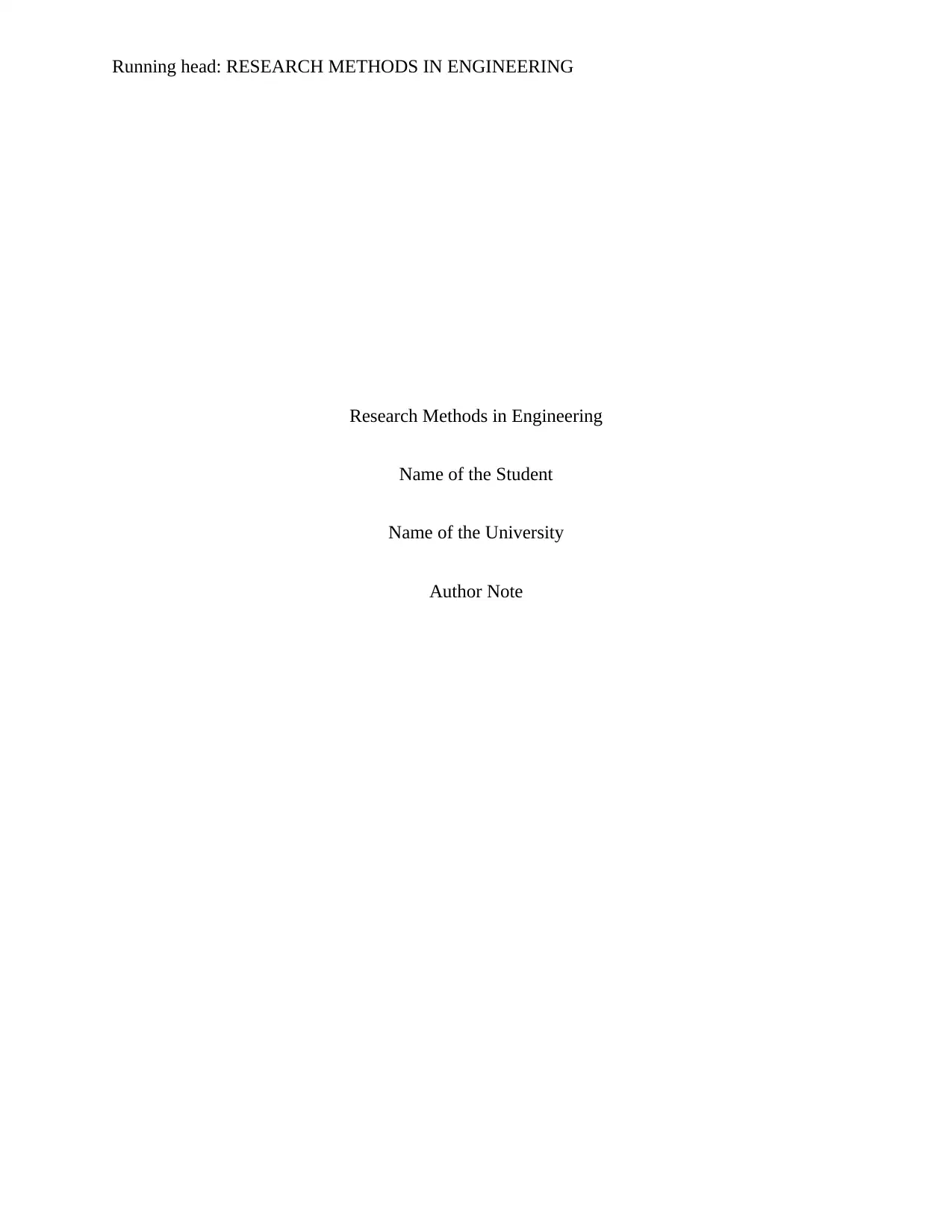
Running head: RESEARCH METHODS IN ENGINEERING
Research Methods in Engineering
Name of the Student
Name of the University
Author Note
Research Methods in Engineering
Name of the Student
Name of the University
Author Note
Paraphrase This Document
Need a fresh take? Get an instant paraphrase of this document with our AI Paraphraser
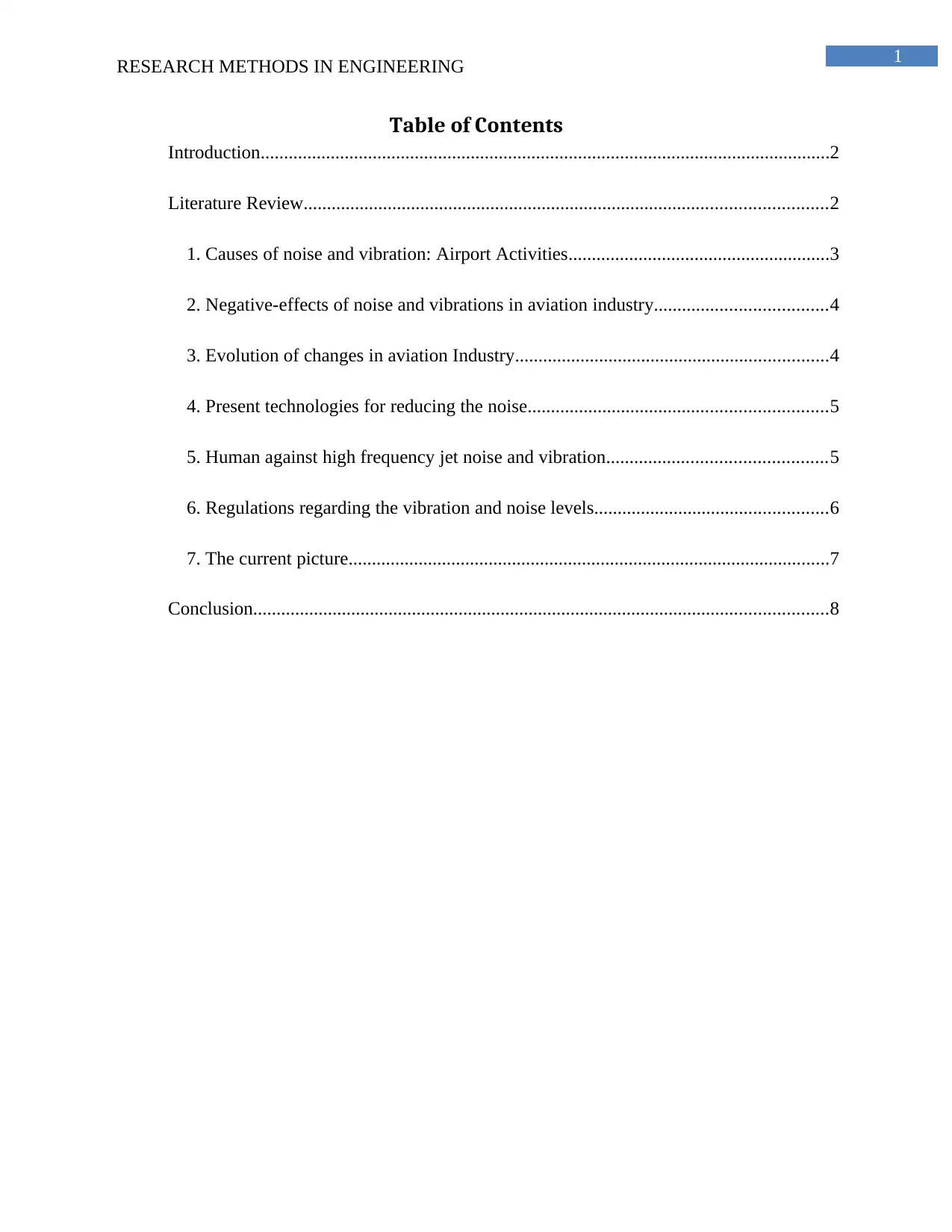
1
RESEARCH METHODS IN ENGINEERING
Table of Contents
Introduction..........................................................................................................................2
Literature Review................................................................................................................2
1. Causes of noise and vibration: Airport Activities........................................................3
2. Negative-effects of noise and vibrations in aviation industry.....................................4
3. Evolution of changes in aviation Industry...................................................................4
4. Present technologies for reducing the noise................................................................5
5. Human against high frequency jet noise and vibration...............................................5
6. Regulations regarding the vibration and noise levels..................................................6
7. The current picture.......................................................................................................7
Conclusion...........................................................................................................................8
RESEARCH METHODS IN ENGINEERING
Table of Contents
Introduction..........................................................................................................................2
Literature Review................................................................................................................2
1. Causes of noise and vibration: Airport Activities........................................................3
2. Negative-effects of noise and vibrations in aviation industry.....................................4
3. Evolution of changes in aviation Industry...................................................................4
4. Present technologies for reducing the noise................................................................5
5. Human against high frequency jet noise and vibration...............................................5
6. Regulations regarding the vibration and noise levels..................................................6
7. The current picture.......................................................................................................7
Conclusion...........................................................................................................................8

2
RESEARCH METHODS IN ENGINEERING
Introduction
With the increase in the use of airways in recent years, certain counter effects associated
with the air traffic in aviation industry has increased as well. The most significant one is the
problems faced by people living near the airport. Continuous exposure to the noise might have an
negative effect on health and well being of the people who are exposed to such noises. The
vibrations are often caused by normal operations of aircraft, which includes, take off, landing
and cruising1. During these operations, the vibration and noises are maximum, which affects the
environment. With the present and advanced technologies, it is possible to control and reduce the
negative effects of vibration and noises associated with the aviation industry, which will be
addressed in this literature review. The purpose of the literature review is to understand the
different types of noise and vibrations and its negative effect on human and environment2. The
literature review will be highlighting the regulations which are in place and the preventive
measures that are taken in order to reduce the negative impacts of the vibration and noise
associated with aviation industry.
Literature Review
The noise and the vibrations that are generated from the aircraft industry are considered
to be a significant problem as it impacts the lives of people who live around airports. There are a
number of reasons behind the cause and generation of aircraft noise3. The main sources of noise
and vibration that are generated from aircrafts are aircraft’s engine and the noise generated as a
result of air going over fuselage and wings. The engine noise is caused and generated by the
exhaust and jet behind the engine4. The effect of noise and vibration generated from aircraft is
huge on the people who live near the airport. The purpose of the literature review is to perform
RESEARCH METHODS IN ENGINEERING
Introduction
With the increase in the use of airways in recent years, certain counter effects associated
with the air traffic in aviation industry has increased as well. The most significant one is the
problems faced by people living near the airport. Continuous exposure to the noise might have an
negative effect on health and well being of the people who are exposed to such noises. The
vibrations are often caused by normal operations of aircraft, which includes, take off, landing
and cruising1. During these operations, the vibration and noises are maximum, which affects the
environment. With the present and advanced technologies, it is possible to control and reduce the
negative effects of vibration and noises associated with the aviation industry, which will be
addressed in this literature review. The purpose of the literature review is to understand the
different types of noise and vibrations and its negative effect on human and environment2. The
literature review will be highlighting the regulations which are in place and the preventive
measures that are taken in order to reduce the negative impacts of the vibration and noise
associated with aviation industry.
Literature Review
The noise and the vibrations that are generated from the aircraft industry are considered
to be a significant problem as it impacts the lives of people who live around airports. There are a
number of reasons behind the cause and generation of aircraft noise3. The main sources of noise
and vibration that are generated from aircrafts are aircraft’s engine and the noise generated as a
result of air going over fuselage and wings. The engine noise is caused and generated by the
exhaust and jet behind the engine4. The effect of noise and vibration generated from aircraft is
huge on the people who live near the airport. The purpose of the literature review is to perform
⊘ This is a preview!⊘
Do you want full access?
Subscribe today to unlock all pages.

Trusted by 1+ million students worldwide
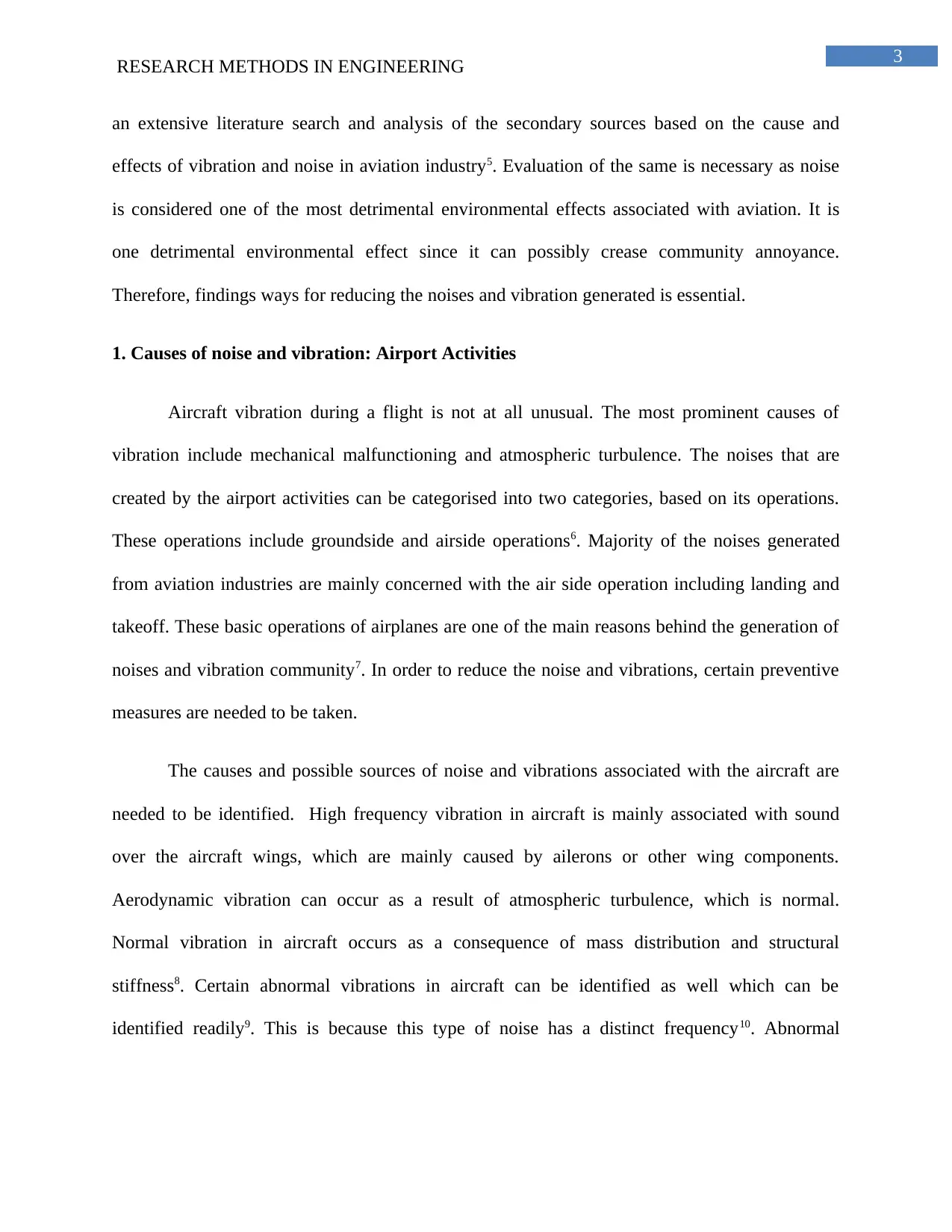
3
RESEARCH METHODS IN ENGINEERING
an extensive literature search and analysis of the secondary sources based on the cause and
effects of vibration and noise in aviation industry5. Evaluation of the same is necessary as noise
is considered one of the most detrimental environmental effects associated with aviation. It is
one detrimental environmental effect since it can possibly crease community annoyance.
Therefore, findings ways for reducing the noises and vibration generated is essential.
1. Causes of noise and vibration: Airport Activities
Aircraft vibration during a flight is not at all unusual. The most prominent causes of
vibration include mechanical malfunctioning and atmospheric turbulence. The noises that are
created by the airport activities can be categorised into two categories, based on its operations.
These operations include groundside and airside operations6. Majority of the noises generated
from aviation industries are mainly concerned with the air side operation including landing and
takeoff. These basic operations of airplanes are one of the main reasons behind the generation of
noises and vibration community7. In order to reduce the noise and vibrations, certain preventive
measures are needed to be taken.
The causes and possible sources of noise and vibrations associated with the aircraft are
needed to be identified. High frequency vibration in aircraft is mainly associated with sound
over the aircraft wings, which are mainly caused by ailerons or other wing components.
Aerodynamic vibration can occur as a result of atmospheric turbulence, which is normal.
Normal vibration in aircraft occurs as a consequence of mass distribution and structural
stiffness8. Certain abnormal vibrations in aircraft can be identified as well which can be
identified readily9. This is because this type of noise has a distinct frequency10. Abnormal
RESEARCH METHODS IN ENGINEERING
an extensive literature search and analysis of the secondary sources based on the cause and
effects of vibration and noise in aviation industry5. Evaluation of the same is necessary as noise
is considered one of the most detrimental environmental effects associated with aviation. It is
one detrimental environmental effect since it can possibly crease community annoyance.
Therefore, findings ways for reducing the noises and vibration generated is essential.
1. Causes of noise and vibration: Airport Activities
Aircraft vibration during a flight is not at all unusual. The most prominent causes of
vibration include mechanical malfunctioning and atmospheric turbulence. The noises that are
created by the airport activities can be categorised into two categories, based on its operations.
These operations include groundside and airside operations6. Majority of the noises generated
from aviation industries are mainly concerned with the air side operation including landing and
takeoff. These basic operations of airplanes are one of the main reasons behind the generation of
noises and vibration community7. In order to reduce the noise and vibrations, certain preventive
measures are needed to be taken.
The causes and possible sources of noise and vibrations associated with the aircraft are
needed to be identified. High frequency vibration in aircraft is mainly associated with sound
over the aircraft wings, which are mainly caused by ailerons or other wing components.
Aerodynamic vibration can occur as a result of atmospheric turbulence, which is normal.
Normal vibration in aircraft occurs as a consequence of mass distribution and structural
stiffness8. Certain abnormal vibrations in aircraft can be identified as well which can be
identified readily9. This is because this type of noise has a distinct frequency10. Abnormal
Paraphrase This Document
Need a fresh take? Get an instant paraphrase of this document with our AI Paraphraser
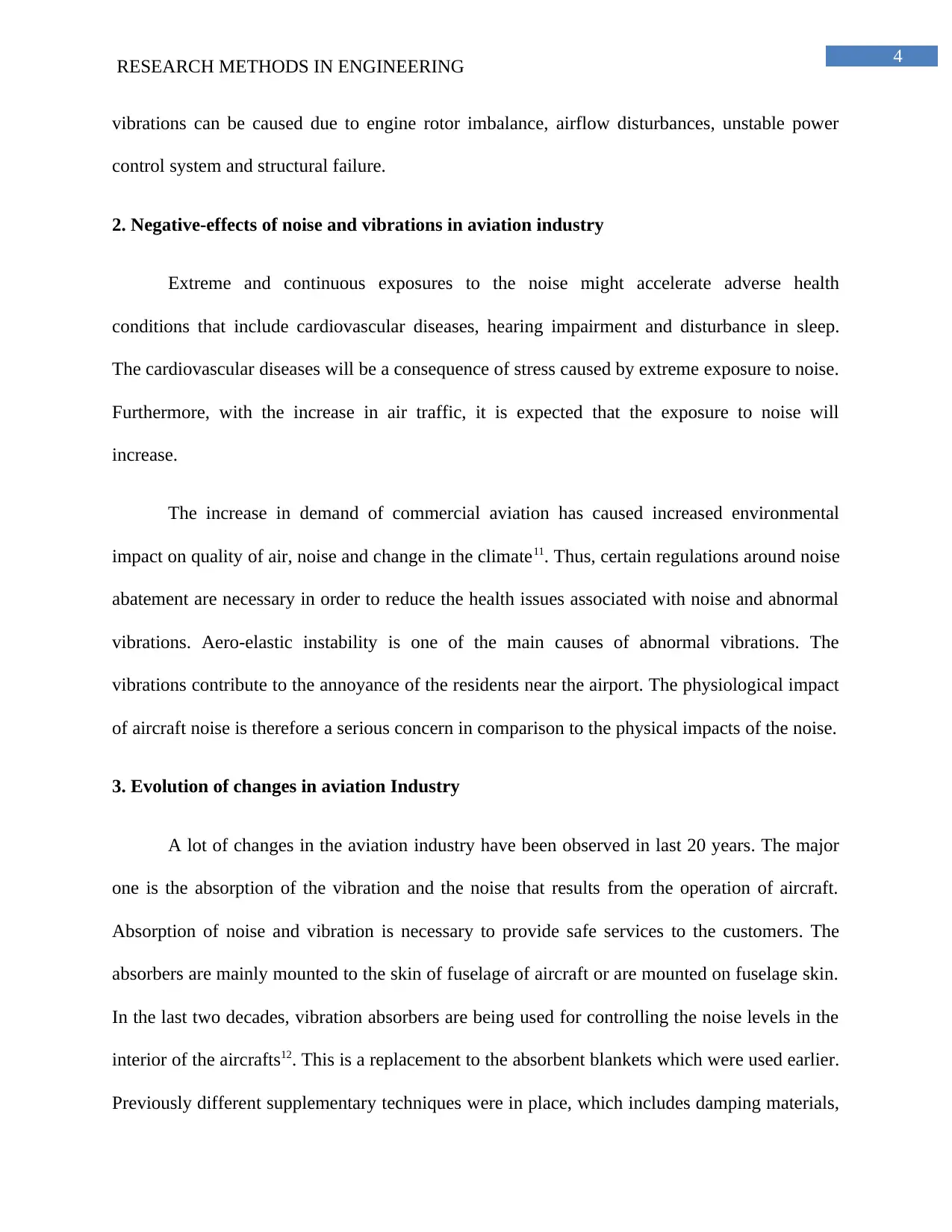
4
RESEARCH METHODS IN ENGINEERING
vibrations can be caused due to engine rotor imbalance, airflow disturbances, unstable power
control system and structural failure.
2. Negative-effects of noise and vibrations in aviation industry
Extreme and continuous exposures to the noise might accelerate adverse health
conditions that include cardiovascular diseases, hearing impairment and disturbance in sleep.
The cardiovascular diseases will be a consequence of stress caused by extreme exposure to noise.
Furthermore, with the increase in air traffic, it is expected that the exposure to noise will
increase.
The increase in demand of commercial aviation has caused increased environmental
impact on quality of air, noise and change in the climate11. Thus, certain regulations around noise
abatement are necessary in order to reduce the health issues associated with noise and abnormal
vibrations. Aero-elastic instability is one of the main causes of abnormal vibrations. The
vibrations contribute to the annoyance of the residents near the airport. The physiological impact
of aircraft noise is therefore a serious concern in comparison to the physical impacts of the noise.
3. Evolution of changes in aviation Industry
A lot of changes in the aviation industry have been observed in last 20 years. The major
one is the absorption of the vibration and the noise that results from the operation of aircraft.
Absorption of noise and vibration is necessary to provide safe services to the customers. The
absorbers are mainly mounted to the skin of fuselage of aircraft or are mounted on fuselage skin.
In the last two decades, vibration absorbers are being used for controlling the noise levels in the
interior of the aircrafts12. This is a replacement to the absorbent blankets which were used earlier.
Previously different supplementary techniques were in place, which includes damping materials,
RESEARCH METHODS IN ENGINEERING
vibrations can be caused due to engine rotor imbalance, airflow disturbances, unstable power
control system and structural failure.
2. Negative-effects of noise and vibrations in aviation industry
Extreme and continuous exposures to the noise might accelerate adverse health
conditions that include cardiovascular diseases, hearing impairment and disturbance in sleep.
The cardiovascular diseases will be a consequence of stress caused by extreme exposure to noise.
Furthermore, with the increase in air traffic, it is expected that the exposure to noise will
increase.
The increase in demand of commercial aviation has caused increased environmental
impact on quality of air, noise and change in the climate11. Thus, certain regulations around noise
abatement are necessary in order to reduce the health issues associated with noise and abnormal
vibrations. Aero-elastic instability is one of the main causes of abnormal vibrations. The
vibrations contribute to the annoyance of the residents near the airport. The physiological impact
of aircraft noise is therefore a serious concern in comparison to the physical impacts of the noise.
3. Evolution of changes in aviation Industry
A lot of changes in the aviation industry have been observed in last 20 years. The major
one is the absorption of the vibration and the noise that results from the operation of aircraft.
Absorption of noise and vibration is necessary to provide safe services to the customers. The
absorbers are mainly mounted to the skin of fuselage of aircraft or are mounted on fuselage skin.
In the last two decades, vibration absorbers are being used for controlling the noise levels in the
interior of the aircrafts12. This is a replacement to the absorbent blankets which were used earlier.
Previously different supplementary techniques were in place, which includes damping materials,
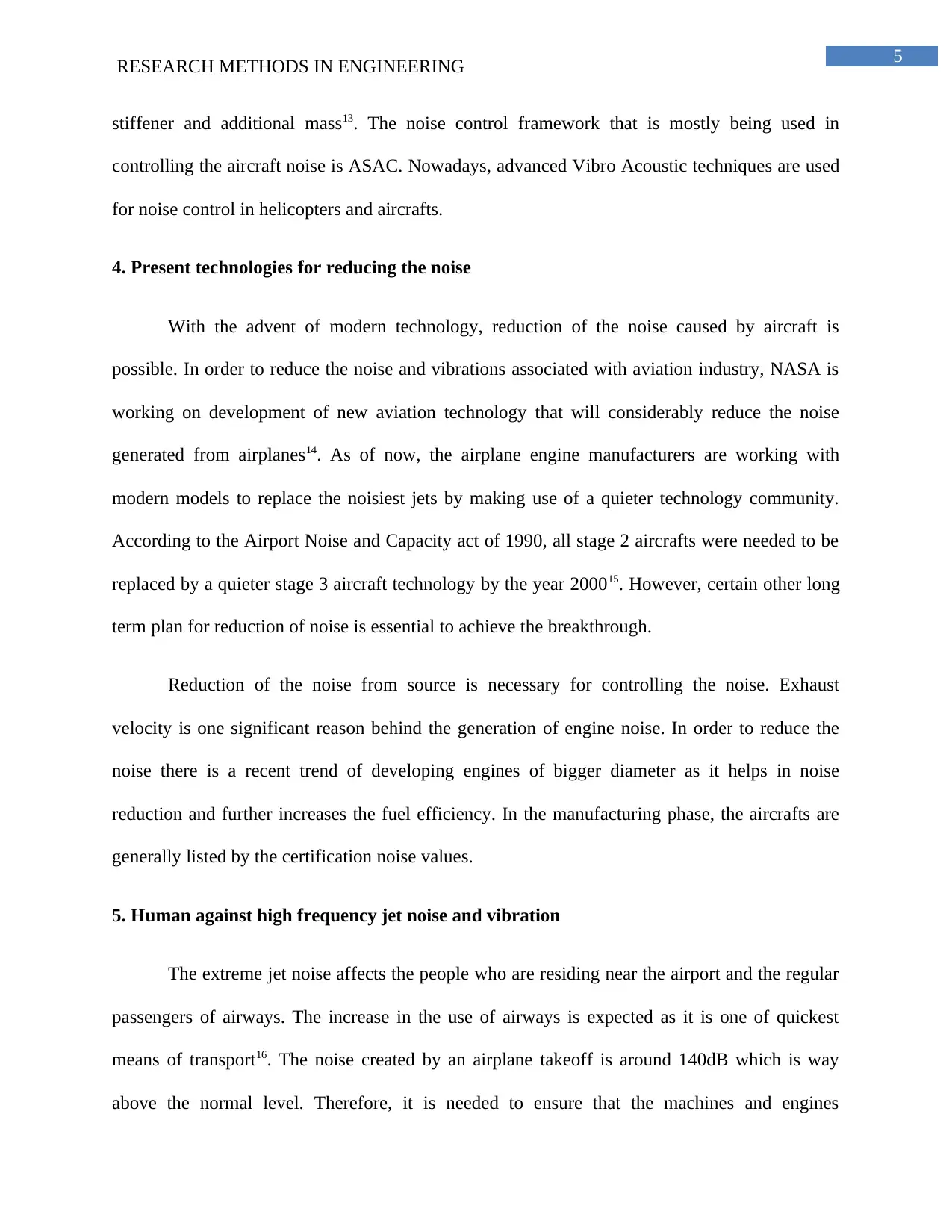
5
RESEARCH METHODS IN ENGINEERING
stiffener and additional mass13. The noise control framework that is mostly being used in
controlling the aircraft noise is ASAC. Nowadays, advanced Vibro Acoustic techniques are used
for noise control in helicopters and aircrafts.
4. Present technologies for reducing the noise
With the advent of modern technology, reduction of the noise caused by aircraft is
possible. In order to reduce the noise and vibrations associated with aviation industry, NASA is
working on development of new aviation technology that will considerably reduce the noise
generated from airplanes14. As of now, the airplane engine manufacturers are working with
modern models to replace the noisiest jets by making use of a quieter technology community.
According to the Airport Noise and Capacity act of 1990, all stage 2 aircrafts were needed to be
replaced by a quieter stage 3 aircraft technology by the year 200015. However, certain other long
term plan for reduction of noise is essential to achieve the breakthrough.
Reduction of the noise from source is necessary for controlling the noise. Exhaust
velocity is one significant reason behind the generation of engine noise. In order to reduce the
noise there is a recent trend of developing engines of bigger diameter as it helps in noise
reduction and further increases the fuel efficiency. In the manufacturing phase, the aircrafts are
generally listed by the certification noise values.
5. Human against high frequency jet noise and vibration
The extreme jet noise affects the people who are residing near the airport and the regular
passengers of airways. The increase in the use of airways is expected as it is one of quickest
means of transport16. The noise created by an airplane takeoff is around 140dB which is way
above the normal level. Therefore, it is needed to ensure that the machines and engines
RESEARCH METHODS IN ENGINEERING
stiffener and additional mass13. The noise control framework that is mostly being used in
controlling the aircraft noise is ASAC. Nowadays, advanced Vibro Acoustic techniques are used
for noise control in helicopters and aircrafts.
4. Present technologies for reducing the noise
With the advent of modern technology, reduction of the noise caused by aircraft is
possible. In order to reduce the noise and vibrations associated with aviation industry, NASA is
working on development of new aviation technology that will considerably reduce the noise
generated from airplanes14. As of now, the airplane engine manufacturers are working with
modern models to replace the noisiest jets by making use of a quieter technology community.
According to the Airport Noise and Capacity act of 1990, all stage 2 aircrafts were needed to be
replaced by a quieter stage 3 aircraft technology by the year 200015. However, certain other long
term plan for reduction of noise is essential to achieve the breakthrough.
Reduction of the noise from source is necessary for controlling the noise. Exhaust
velocity is one significant reason behind the generation of engine noise. In order to reduce the
noise there is a recent trend of developing engines of bigger diameter as it helps in noise
reduction and further increases the fuel efficiency. In the manufacturing phase, the aircrafts are
generally listed by the certification noise values.
5. Human against high frequency jet noise and vibration
The extreme jet noise affects the people who are residing near the airport and the regular
passengers of airways. The increase in the use of airways is expected as it is one of quickest
means of transport16. The noise created by an airplane takeoff is around 140dB which is way
above the normal level. Therefore, it is needed to ensure that the machines and engines
⊘ This is a preview!⊘
Do you want full access?
Subscribe today to unlock all pages.

Trusted by 1+ million students worldwide
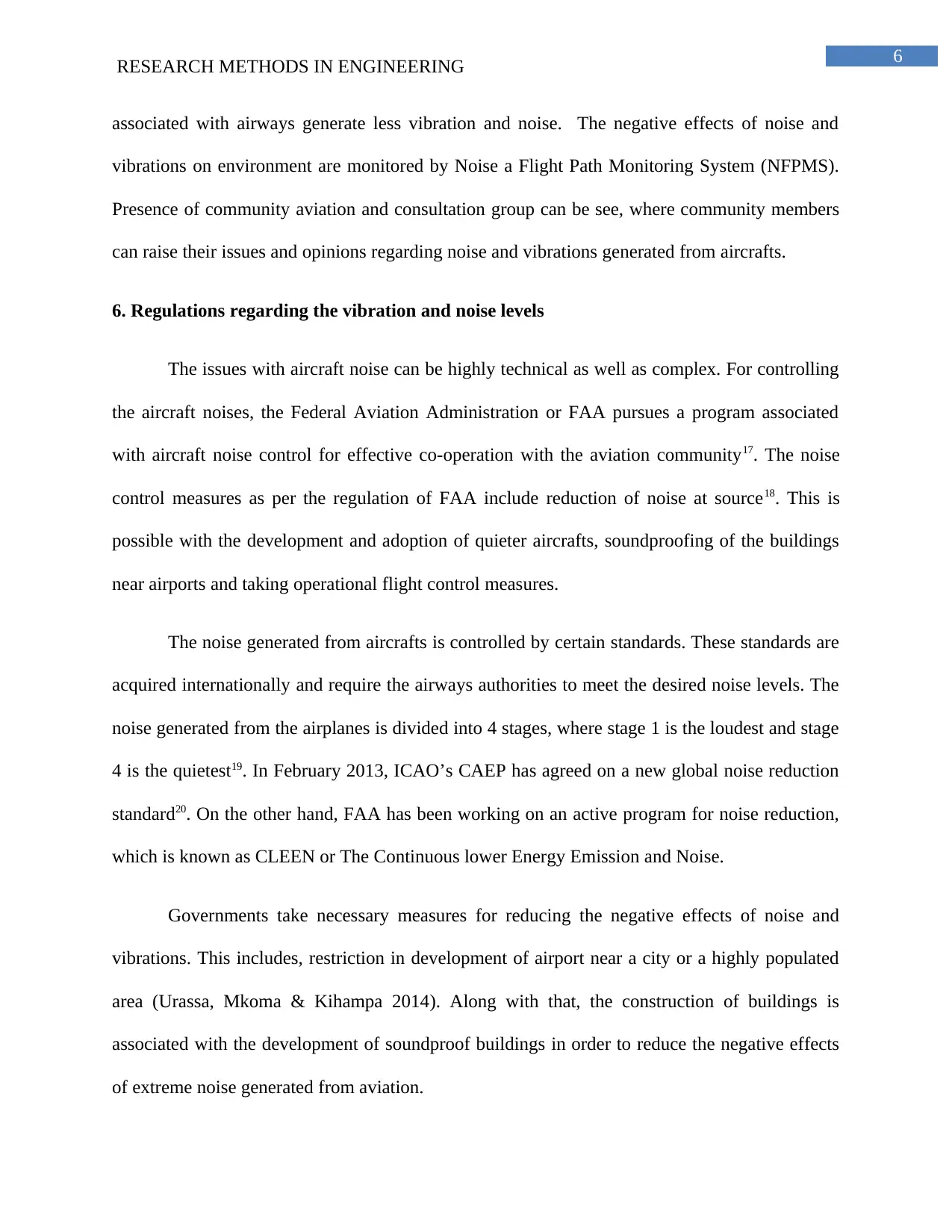
6
RESEARCH METHODS IN ENGINEERING
associated with airways generate less vibration and noise. The negative effects of noise and
vibrations on environment are monitored by Noise a Flight Path Monitoring System (NFPMS).
Presence of community aviation and consultation group can be see, where community members
can raise their issues and opinions regarding noise and vibrations generated from aircrafts.
6. Regulations regarding the vibration and noise levels
The issues with aircraft noise can be highly technical as well as complex. For controlling
the aircraft noises, the Federal Aviation Administration or FAA pursues a program associated
with aircraft noise control for effective co-operation with the aviation community17. The noise
control measures as per the regulation of FAA include reduction of noise at source18. This is
possible with the development and adoption of quieter aircrafts, soundproofing of the buildings
near airports and taking operational flight control measures.
The noise generated from aircrafts is controlled by certain standards. These standards are
acquired internationally and require the airways authorities to meet the desired noise levels. The
noise generated from the airplanes is divided into 4 stages, where stage 1 is the loudest and stage
4 is the quietest19. In February 2013, ICAO’s CAEP has agreed on a new global noise reduction
standard20. On the other hand, FAA has been working on an active program for noise reduction,
which is known as CLEEN or The Continuous lower Energy Emission and Noise.
Governments take necessary measures for reducing the negative effects of noise and
vibrations. This includes, restriction in development of airport near a city or a highly populated
area (Urassa, Mkoma & Kihampa 2014). Along with that, the construction of buildings is
associated with the development of soundproof buildings in order to reduce the negative effects
of extreme noise generated from aviation.
RESEARCH METHODS IN ENGINEERING
associated with airways generate less vibration and noise. The negative effects of noise and
vibrations on environment are monitored by Noise a Flight Path Monitoring System (NFPMS).
Presence of community aviation and consultation group can be see, where community members
can raise their issues and opinions regarding noise and vibrations generated from aircrafts.
6. Regulations regarding the vibration and noise levels
The issues with aircraft noise can be highly technical as well as complex. For controlling
the aircraft noises, the Federal Aviation Administration or FAA pursues a program associated
with aircraft noise control for effective co-operation with the aviation community17. The noise
control measures as per the regulation of FAA include reduction of noise at source18. This is
possible with the development and adoption of quieter aircrafts, soundproofing of the buildings
near airports and taking operational flight control measures.
The noise generated from aircrafts is controlled by certain standards. These standards are
acquired internationally and require the airways authorities to meet the desired noise levels. The
noise generated from the airplanes is divided into 4 stages, where stage 1 is the loudest and stage
4 is the quietest19. In February 2013, ICAO’s CAEP has agreed on a new global noise reduction
standard20. On the other hand, FAA has been working on an active program for noise reduction,
which is known as CLEEN or The Continuous lower Energy Emission and Noise.
Governments take necessary measures for reducing the negative effects of noise and
vibrations. This includes, restriction in development of airport near a city or a highly populated
area (Urassa, Mkoma & Kihampa 2014). Along with that, the construction of buildings is
associated with the development of soundproof buildings in order to reduce the negative effects
of extreme noise generated from aviation.
Paraphrase This Document
Need a fresh take? Get an instant paraphrase of this document with our AI Paraphraser
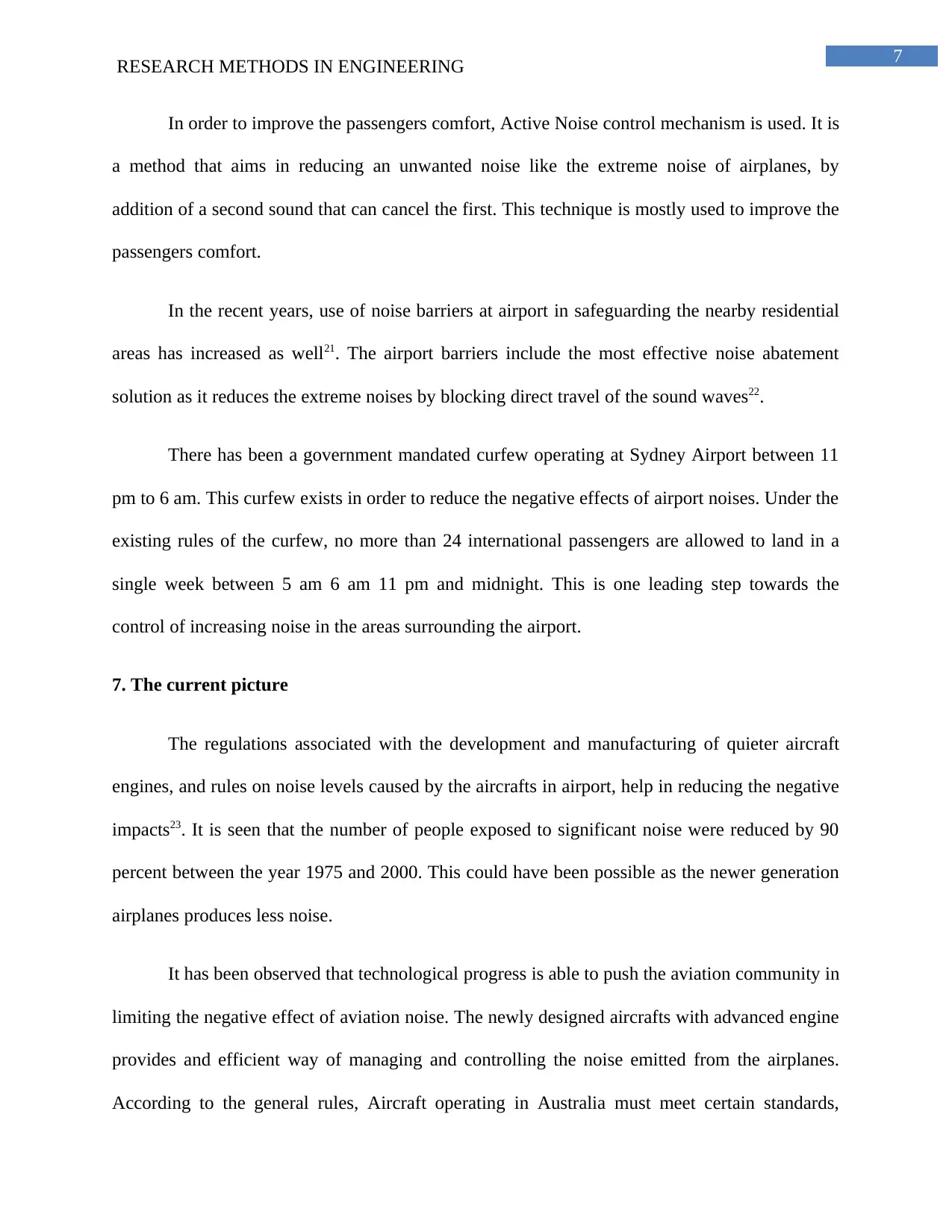
7
RESEARCH METHODS IN ENGINEERING
In order to improve the passengers comfort, Active Noise control mechanism is used. It is
a method that aims in reducing an unwanted noise like the extreme noise of airplanes, by
addition of a second sound that can cancel the first. This technique is mostly used to improve the
passengers comfort.
In the recent years, use of noise barriers at airport in safeguarding the nearby residential
areas has increased as well21. The airport barriers include the most effective noise abatement
solution as it reduces the extreme noises by blocking direct travel of the sound waves22.
There has been a government mandated curfew operating at Sydney Airport between 11
pm to 6 am. This curfew exists in order to reduce the negative effects of airport noises. Under the
existing rules of the curfew, no more than 24 international passengers are allowed to land in a
single week between 5 am 6 am 11 pm and midnight. This is one leading step towards the
control of increasing noise in the areas surrounding the airport.
7. The current picture
The regulations associated with the development and manufacturing of quieter aircraft
engines, and rules on noise levels caused by the aircrafts in airport, help in reducing the negative
impacts23. It is seen that the number of people exposed to significant noise were reduced by 90
percent between the year 1975 and 2000. This could have been possible as the newer generation
airplanes produces less noise.
It has been observed that technological progress is able to push the aviation community in
limiting the negative effect of aviation noise. The newly designed aircrafts with advanced engine
provides and efficient way of managing and controlling the noise emitted from the airplanes.
According to the general rules, Aircraft operating in Australia must meet certain standards,
RESEARCH METHODS IN ENGINEERING
In order to improve the passengers comfort, Active Noise control mechanism is used. It is
a method that aims in reducing an unwanted noise like the extreme noise of airplanes, by
addition of a second sound that can cancel the first. This technique is mostly used to improve the
passengers comfort.
In the recent years, use of noise barriers at airport in safeguarding the nearby residential
areas has increased as well21. The airport barriers include the most effective noise abatement
solution as it reduces the extreme noises by blocking direct travel of the sound waves22.
There has been a government mandated curfew operating at Sydney Airport between 11
pm to 6 am. This curfew exists in order to reduce the negative effects of airport noises. Under the
existing rules of the curfew, no more than 24 international passengers are allowed to land in a
single week between 5 am 6 am 11 pm and midnight. This is one leading step towards the
control of increasing noise in the areas surrounding the airport.
7. The current picture
The regulations associated with the development and manufacturing of quieter aircraft
engines, and rules on noise levels caused by the aircrafts in airport, help in reducing the negative
impacts23. It is seen that the number of people exposed to significant noise were reduced by 90
percent between the year 1975 and 2000. This could have been possible as the newer generation
airplanes produces less noise.
It has been observed that technological progress is able to push the aviation community in
limiting the negative effect of aviation noise. The newly designed aircrafts with advanced engine
provides and efficient way of managing and controlling the noise emitted from the airplanes.
According to the general rules, Aircraft operating in Australia must meet certain standards,
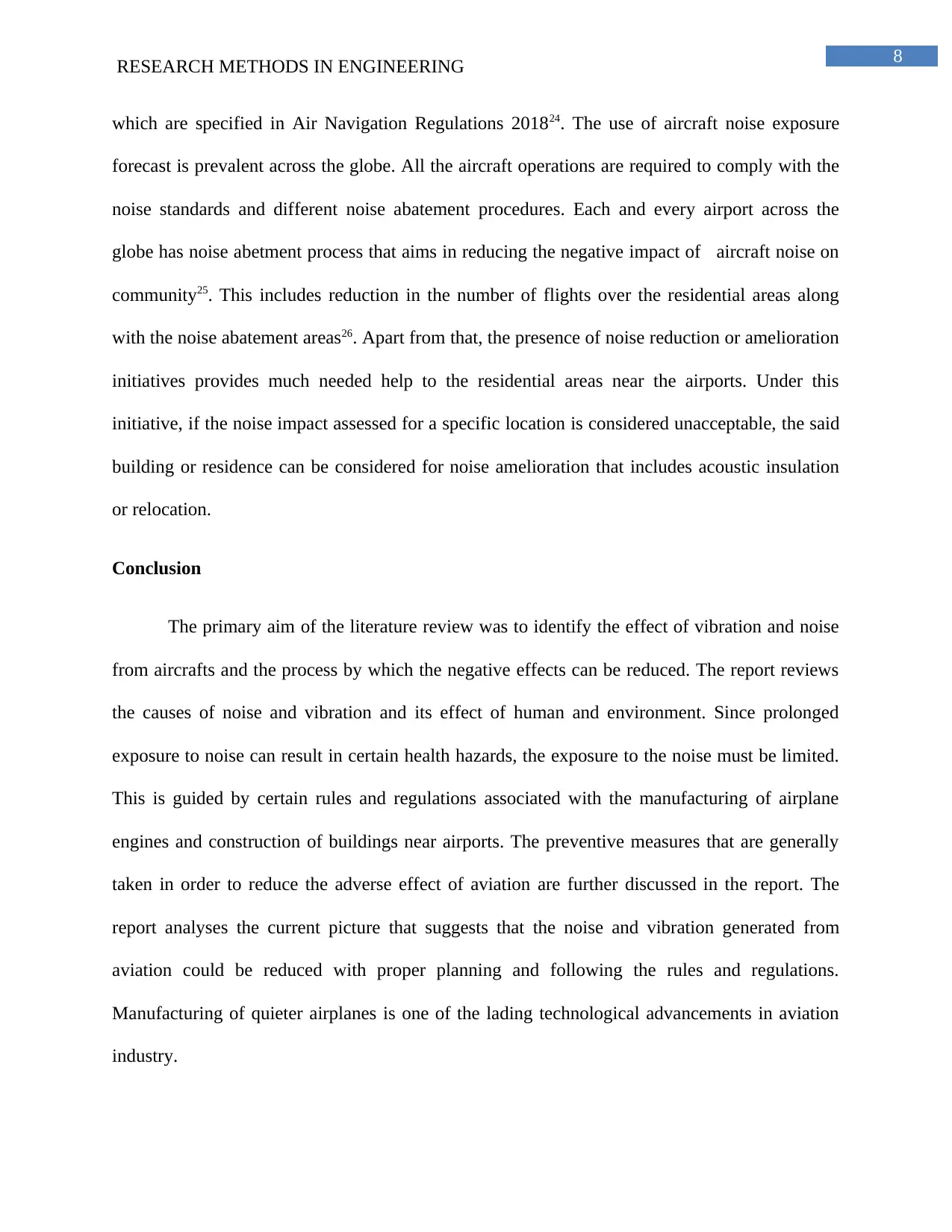
8
RESEARCH METHODS IN ENGINEERING
which are specified in Air Navigation Regulations 201824. The use of aircraft noise exposure
forecast is prevalent across the globe. All the aircraft operations are required to comply with the
noise standards and different noise abatement procedures. Each and every airport across the
globe has noise abetment process that aims in reducing the negative impact of aircraft noise on
community25. This includes reduction in the number of flights over the residential areas along
with the noise abatement areas26. Apart from that, the presence of noise reduction or amelioration
initiatives provides much needed help to the residential areas near the airports. Under this
initiative, if the noise impact assessed for a specific location is considered unacceptable, the said
building or residence can be considered for noise amelioration that includes acoustic insulation
or relocation.
Conclusion
The primary aim of the literature review was to identify the effect of vibration and noise
from aircrafts and the process by which the negative effects can be reduced. The report reviews
the causes of noise and vibration and its effect of human and environment. Since prolonged
exposure to noise can result in certain health hazards, the exposure to the noise must be limited.
This is guided by certain rules and regulations associated with the manufacturing of airplane
engines and construction of buildings near airports. The preventive measures that are generally
taken in order to reduce the adverse effect of aviation are further discussed in the report. The
report analyses the current picture that suggests that the noise and vibration generated from
aviation could be reduced with proper planning and following the rules and regulations.
Manufacturing of quieter airplanes is one of the lading technological advancements in aviation
industry.
RESEARCH METHODS IN ENGINEERING
which are specified in Air Navigation Regulations 201824. The use of aircraft noise exposure
forecast is prevalent across the globe. All the aircraft operations are required to comply with the
noise standards and different noise abatement procedures. Each and every airport across the
globe has noise abetment process that aims in reducing the negative impact of aircraft noise on
community25. This includes reduction in the number of flights over the residential areas along
with the noise abatement areas26. Apart from that, the presence of noise reduction or amelioration
initiatives provides much needed help to the residential areas near the airports. Under this
initiative, if the noise impact assessed for a specific location is considered unacceptable, the said
building or residence can be considered for noise amelioration that includes acoustic insulation
or relocation.
Conclusion
The primary aim of the literature review was to identify the effect of vibration and noise
from aircrafts and the process by which the negative effects can be reduced. The report reviews
the causes of noise and vibration and its effect of human and environment. Since prolonged
exposure to noise can result in certain health hazards, the exposure to the noise must be limited.
This is guided by certain rules and regulations associated with the manufacturing of airplane
engines and construction of buildings near airports. The preventive measures that are generally
taken in order to reduce the adverse effect of aviation are further discussed in the report. The
report analyses the current picture that suggests that the noise and vibration generated from
aviation could be reduced with proper planning and following the rules and regulations.
Manufacturing of quieter airplanes is one of the lading technological advancements in aviation
industry.
⊘ This is a preview!⊘
Do you want full access?
Subscribe today to unlock all pages.

Trusted by 1+ million students worldwide
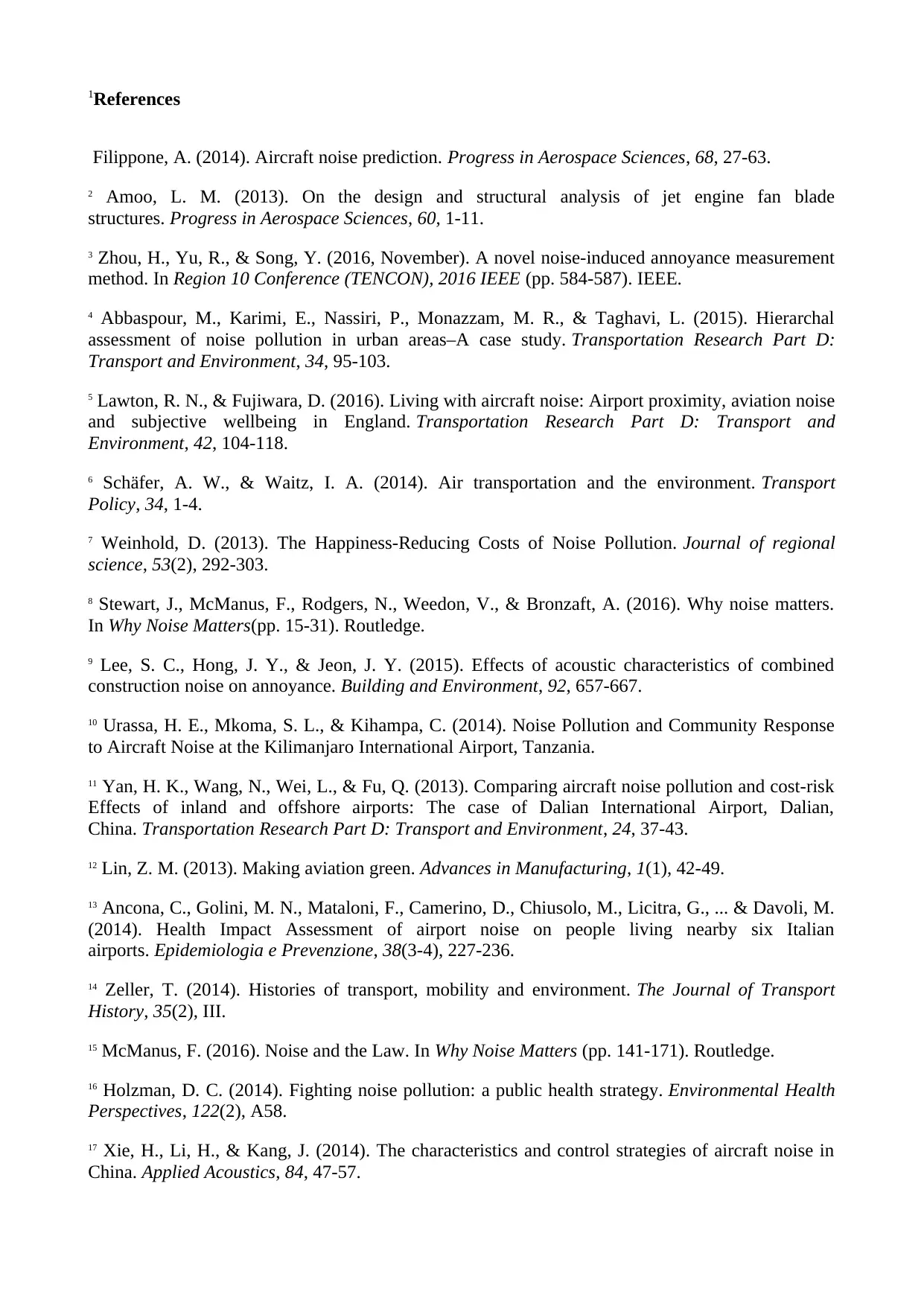
1References
Filippone, A. (2014). Aircraft noise prediction. Progress in Aerospace Sciences, 68, 27-63.
2 Amoo, L. M. (2013). On the design and structural analysis of jet engine fan blade
structures. Progress in Aerospace Sciences, 60, 1-11.
3 Zhou, H., Yu, R., & Song, Y. (2016, November). A novel noise-induced annoyance measurement
method. In Region 10 Conference (TENCON), 2016 IEEE (pp. 584-587). IEEE.
4 Abbaspour, M., Karimi, E., Nassiri, P., Monazzam, M. R., & Taghavi, L. (2015). Hierarchal
assessment of noise pollution in urban areas–A case study. Transportation Research Part D:
Transport and Environment, 34, 95-103.
5 Lawton, R. N., & Fujiwara, D. (2016). Living with aircraft noise: Airport proximity, aviation noise
and subjective wellbeing in England. Transportation Research Part D: Transport and
Environment, 42, 104-118.
6 Schäfer, A. W., & Waitz, I. A. (2014). Air transportation and the environment. Transport
Policy, 34, 1-4.
7 Weinhold, D. (2013). The Happiness‐Reducing Costs of Noise Pollution. Journal of regional
science, 53(2), 292-303.
8 Stewart, J., McManus, F., Rodgers, N., Weedon, V., & Bronzaft, A. (2016). Why noise matters.
In Why Noise Matters(pp. 15-31). Routledge.
9 Lee, S. C., Hong, J. Y., & Jeon, J. Y. (2015). Effects of acoustic characteristics of combined
construction noise on annoyance. Building and Environment, 92, 657-667.
10 Urassa, H. E., Mkoma, S. L., & Kihampa, C. (2014). Noise Pollution and Community Response
to Aircraft Noise at the Kilimanjaro International Airport, Tanzania.
11 Yan, H. K., Wang, N., Wei, L., & Fu, Q. (2013). Comparing aircraft noise pollution and cost-risk
Effects of inland and offshore airports: The case of Dalian International Airport, Dalian,
China. Transportation Research Part D: Transport and Environment, 24, 37-43.
12 Lin, Z. M. (2013). Making aviation green. Advances in Manufacturing, 1(1), 42-49.
13 Ancona, C., Golini, M. N., Mataloni, F., Camerino, D., Chiusolo, M., Licitra, G., ... & Davoli, M.
(2014). Health Impact Assessment of airport noise on people living nearby six Italian
airports. Epidemiologia e Prevenzione, 38(3-4), 227-236.
14 Zeller, T. (2014). Histories of transport, mobility and environment. The Journal of Transport
History, 35(2), III.
15 McManus, F. (2016). Noise and the Law. In Why Noise Matters (pp. 141-171). Routledge.
16 Holzman, D. C. (2014). Fighting noise pollution: a public health strategy. Environmental Health
Perspectives, 122(2), A58.
17 Xie, H., Li, H., & Kang, J. (2014). The characteristics and control strategies of aircraft noise in
China. Applied Acoustics, 84, 47-57.
Filippone, A. (2014). Aircraft noise prediction. Progress in Aerospace Sciences, 68, 27-63.
2 Amoo, L. M. (2013). On the design and structural analysis of jet engine fan blade
structures. Progress in Aerospace Sciences, 60, 1-11.
3 Zhou, H., Yu, R., & Song, Y. (2016, November). A novel noise-induced annoyance measurement
method. In Region 10 Conference (TENCON), 2016 IEEE (pp. 584-587). IEEE.
4 Abbaspour, M., Karimi, E., Nassiri, P., Monazzam, M. R., & Taghavi, L. (2015). Hierarchal
assessment of noise pollution in urban areas–A case study. Transportation Research Part D:
Transport and Environment, 34, 95-103.
5 Lawton, R. N., & Fujiwara, D. (2016). Living with aircraft noise: Airport proximity, aviation noise
and subjective wellbeing in England. Transportation Research Part D: Transport and
Environment, 42, 104-118.
6 Schäfer, A. W., & Waitz, I. A. (2014). Air transportation and the environment. Transport
Policy, 34, 1-4.
7 Weinhold, D. (2013). The Happiness‐Reducing Costs of Noise Pollution. Journal of regional
science, 53(2), 292-303.
8 Stewart, J., McManus, F., Rodgers, N., Weedon, V., & Bronzaft, A. (2016). Why noise matters.
In Why Noise Matters(pp. 15-31). Routledge.
9 Lee, S. C., Hong, J. Y., & Jeon, J. Y. (2015). Effects of acoustic characteristics of combined
construction noise on annoyance. Building and Environment, 92, 657-667.
10 Urassa, H. E., Mkoma, S. L., & Kihampa, C. (2014). Noise Pollution and Community Response
to Aircraft Noise at the Kilimanjaro International Airport, Tanzania.
11 Yan, H. K., Wang, N., Wei, L., & Fu, Q. (2013). Comparing aircraft noise pollution and cost-risk
Effects of inland and offshore airports: The case of Dalian International Airport, Dalian,
China. Transportation Research Part D: Transport and Environment, 24, 37-43.
12 Lin, Z. M. (2013). Making aviation green. Advances in Manufacturing, 1(1), 42-49.
13 Ancona, C., Golini, M. N., Mataloni, F., Camerino, D., Chiusolo, M., Licitra, G., ... & Davoli, M.
(2014). Health Impact Assessment of airport noise on people living nearby six Italian
airports. Epidemiologia e Prevenzione, 38(3-4), 227-236.
14 Zeller, T. (2014). Histories of transport, mobility and environment. The Journal of Transport
History, 35(2), III.
15 McManus, F. (2016). Noise and the Law. In Why Noise Matters (pp. 141-171). Routledge.
16 Holzman, D. C. (2014). Fighting noise pollution: a public health strategy. Environmental Health
Perspectives, 122(2), A58.
17 Xie, H., Li, H., & Kang, J. (2014). The characteristics and control strategies of aircraft noise in
China. Applied Acoustics, 84, 47-57.
Paraphrase This Document
Need a fresh take? Get an instant paraphrase of this document with our AI Paraphraser

18 Can, A. (2015). Noise Pollution Indicators. In Environmental Indicators (pp. 501-513). Springer,
Dordrecht.
19 Zhou, H., Yu, R., & Song, Y. (2016, November). A novel noise-induced annoyance measurement
method. In Region 10 Conference (TENCON), 2016 IEEE (pp. 584-587). IEEE.
20 n Region 10 Conference (TENCON), 2016 IEEE (pp. 584-587). IEEE.
Shyu, K. K., Ho, C. Y., & Chang, C. Y. (2014, November). A study on using
microcontroller to design active noise control systems. In Circuits and Systems (APCCAS), 2014
IEEE Asia Pacific Conference on (pp. 443-446). IEEE.
21 Schäfer, A. W., & Waitz, I. A. (2014). Air transportation and the environment. Transport
Policy, 34, 1-4.
22 Ordoukhanian, E., & Madni, A. M. (2014). Blended wing body architecting and design: current
status and future prospects. Procedia Computer Science, 28, 619-625.
23 Ragettli, M. S., Goudreau, S., Plante, C., Perron, S., Fournier, M., & Smargiassi, A. (2015).
Annoyance from road traffic, trains, airplanes and from total environmental noise
levels. International journal of environmental research and public health, 13(1), 90.
24 Stahl, H. (2013). Preparing for landing, ready for take-off. Zoning noise pollution as spatio-
temporal practices at Berlin-Tegel and Berlin-Tempelhof airport (1965-1975). Historical Social
Research/Historische Sozialforschung, 229-245.
25 Fernández, L. P. S., Pérez, L. A. S., & Hernández, J. J. C. (2013). Monitoring system of
environment noise and pattern recognition. In PROCEEDINGS OF THE 2013 INTERNATIONAL
CONFERENCE ON ENVIRONMENT, ENERGY, ECOSYSTEMS AND DEVELOPMENT,
MEXICO.
26 Sánchez-Pérez, L. A., Sánchez-Fernández, L. P., Suárez-Guerra, S., & Carbajal-Hernández, J. J.
(2013). Aircraft class identification based on take-off noise signal segmentation in time. Expert
Systems with Applications, 40(13), 5148-5159.
Dordrecht.
19 Zhou, H., Yu, R., & Song, Y. (2016, November). A novel noise-induced annoyance measurement
method. In Region 10 Conference (TENCON), 2016 IEEE (pp. 584-587). IEEE.
20 n Region 10 Conference (TENCON), 2016 IEEE (pp. 584-587). IEEE.
Shyu, K. K., Ho, C. Y., & Chang, C. Y. (2014, November). A study on using
microcontroller to design active noise control systems. In Circuits and Systems (APCCAS), 2014
IEEE Asia Pacific Conference on (pp. 443-446). IEEE.
21 Schäfer, A. W., & Waitz, I. A. (2014). Air transportation and the environment. Transport
Policy, 34, 1-4.
22 Ordoukhanian, E., & Madni, A. M. (2014). Blended wing body architecting and design: current
status and future prospects. Procedia Computer Science, 28, 619-625.
23 Ragettli, M. S., Goudreau, S., Plante, C., Perron, S., Fournier, M., & Smargiassi, A. (2015).
Annoyance from road traffic, trains, airplanes and from total environmental noise
levels. International journal of environmental research and public health, 13(1), 90.
24 Stahl, H. (2013). Preparing for landing, ready for take-off. Zoning noise pollution as spatio-
temporal practices at Berlin-Tegel and Berlin-Tempelhof airport (1965-1975). Historical Social
Research/Historische Sozialforschung, 229-245.
25 Fernández, L. P. S., Pérez, L. A. S., & Hernández, J. J. C. (2013). Monitoring system of
environment noise and pattern recognition. In PROCEEDINGS OF THE 2013 INTERNATIONAL
CONFERENCE ON ENVIRONMENT, ENERGY, ECOSYSTEMS AND DEVELOPMENT,
MEXICO.
26 Sánchez-Pérez, L. A., Sánchez-Fernández, L. P., Suárez-Guerra, S., & Carbajal-Hernández, J. J.
(2013). Aircraft class identification based on take-off noise signal segmentation in time. Expert
Systems with Applications, 40(13), 5148-5159.
1 out of 11
Related Documents
Your All-in-One AI-Powered Toolkit for Academic Success.
+13062052269
info@desklib.com
Available 24*7 on WhatsApp / Email
![[object Object]](/_next/static/media/star-bottom.7253800d.svg)
Unlock your academic potential
© 2024 | Zucol Services PVT LTD | All rights reserved.





